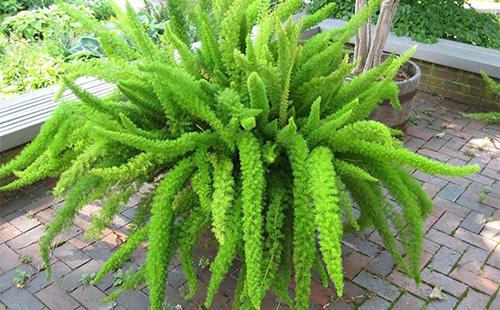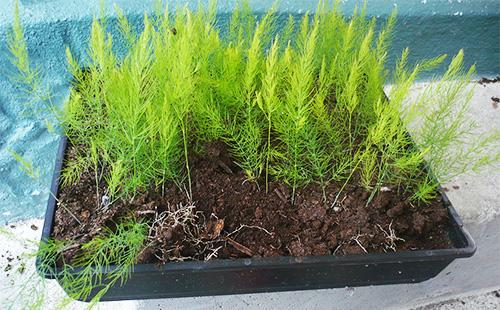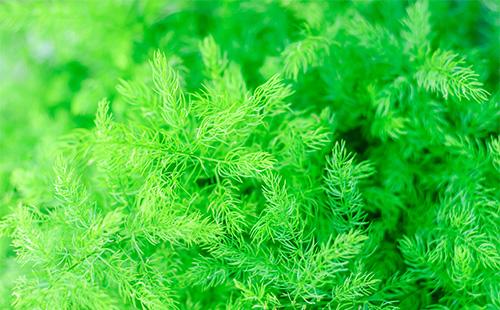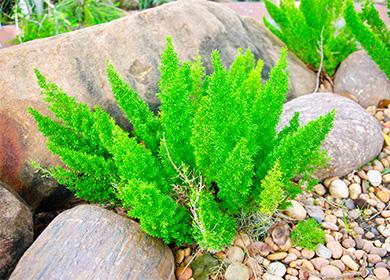The content of the article
Asparagus cannot boast of beautiful or lush flowers. Small inconspicuous inflorescences have absolutely no attractive appearance or aroma. The "highlight" of this plant is enclosed in greenery. Small needles instead of leaves create a lively openwork pattern, which designers are happy to use in landscaping.
Plant description
This plant botany belongs to the asparagus family. About 300 varieties of asparagus are known. Some of them have decorative leaves. Others are characterized by curly branches that look spectacular in a hanging basket.
The main "indoor" types
Representatives of a large genus of asparagus are completely different from each other. Therefore, some of its species often cause confusion even among experienced gardeners. Most often, only five types of asparagus are used for home decoration, described in the table.
Table - Common types of asparagus for indoor gardening
| Asparagus view | Characteristics | Preferences (what to look for) |
|---|---|---|
| Pinnate | - A small and low shrub; - instead of leaves, thin needles; - plain white flowers; - at home it blooms very rarely; - after flowering, dark blue poisonous fruit-beads are formed | - Loves shaded places with a small amount of light; - cannot stand the bright rays of the sun |
| Asparagus | - Ampel bush (intended for cultivation in a cache-pot); - branches can reach 1.5 m; - small needles give the branches fluffy; - the plant has a bright green juicy color; - after flowering, black berries with an orange smell appear | - Long branches often need support; - does not tolerate heat and severe cooling |
| Meyer | - Exotic unusual plant; - The superficial branches are most often erect, raised up; - the shoots are covered with many small needles and resemble a “fox tail”; - In summer, white flowers appear with a pleasant aroma; - crimson berries form from flowers | - The plant has a well-developed root system, therefore, requires a spacious pot; - for successful growth, you need to periodically transplant |
| Crescent | - A small liana; - curly shoots with small thorns; - the leaves are deep green, and eventually acquire a dark shade | - Does not tolerate heat; - loves warmth; - in the summer needs plentiful watering and spraying |
| Sprenger | - Low shrub; - branches can reach 1.8 m; - shoots are covered with needles or oval leaves | - It can tolerate even direct rays of the sun; - temperature not lower than + 15 ° С |
Asparagus: essential care
How to care for asparagus? The plant is completely undemanding and capricious. Therefore, problems with its development practically do not arise. But in order for your room to be constantly decorated with fluffy and beautiful asparagus, you must adhere to some rules.
Location selection and lighting
Pay attention to the choice of place. If the selected site does not fit the asparagus, then it can simply “burn out” or instead of bright green you will see yellow ugly needles. Therefore, determining the place of your green pet, consider three recommendations.
- Diffuse lighting. Almost all asparaguses prefer diffused lighting and cannot stand the bright rays of the sun. Therefore, it is better for them to choose a place on the western or eastern windows. But there are exceptions. So the asparagus of Sprenger can even be placed on the southern windows under the rays of the sun. A cirrus species is desirable to transfer to partial shade.
- Deficit of light. In winter, the flower may lack light. To ensure normal conditions, it can be moved closer to lighting.
- Gradual learning. In the store, the plant is rarely found in sufficient lighting. Therefore, bringing home your pet, do not expose its delicate branches to strong light. Give him time to acclimatize, and gradually accustom him to a new place.
Temperature
By temperature, the plant is quite undemanding. And, despite its tropical roots (they consider Africa and South America to be the birthplace of asparagus), the European climate is easily tolerated. The flower develops normally in the following conditions.
- Summer. This is the period of vegetation, rapid growth of the plant. Therefore, a temperature of + 20 ° C - + 25 ° C is recommended. Moreover, it should not increase. The flower does not tolerate heat.
- In the winter. From November to February there comes a period of rest. At this time, asparagus needs a cooler temperature, optimally - + 14 ° C - + 15 ° C. To recreate such indicators, you can put the plant on the window, closer to the glass or put a flower between the frames.
Watering and humidity
The tropic is a big lover of water. And in low humidity conditions it can quickly die. Therefore, provide the following conditions for asparagus.
- Timely watering. The plant needs constant hydration. The soil in the pot should not dry out. However, asparagus should not be poured. Make sure that the water does not stagnate in the pan, otherwise the roots of the flower will begin to rot.
- High humidity. According to reviews, the plant grows much better in conditions of high humidity. And this is especially important in winter, when the included heating creates excessively dry air. To ensure sufficient moisture, you can put a small container of water on the window.
- Constant spraying. A native of the tropics loves swimming. Therefore, it is necessary to periodically spray it from the spray gun or to arrange for it a real shower in the bathroom.
- Reduced watering. In winter, it is necessary to significantly reduce the spraying of the plant and its watering. But it is important to monitor the soil. It should not dry out.

Top dressing
Asparagus is growing quite actively. Therefore, the plant needs top dressing, ensuring the normal development of the culture. Florists are advised to adhere to the following recommendations:
- feeding frequency - during the growing season, the plant is fertilized every 14 days;
- fertilizer selection - the most useful mineral complexes for decorative and deciduous flowers "Gilea", "Master", "Agricola";
- hibernation - during rest, one feeding a month is enough.
Pruning
Pruning is done to rejuvenate asparagus. However, too often resorting to this method is not worth it, otherwise you can completely destroy the handsome man from the tropics. Florists recommend:
- pluck the bottom tubers - but only those that do not form greenery break off;
- cut old shoots - This is important for enhancing the growth of young branches.
Transfer
Rhizome grows quite quickly, so every year in the spring a young plant is transplanted into a larger pot. And an adult copy can be transshipped once every two to three years. To transplant asparagus correctly, use four tips.
- Choose a time. Plant transplantation is possible only before the start of the growing season, in February or early March. If the period of active growth has begun, then the flower should not be injured.
- Prepare the ground. A universal soil is suitable for this culture. If you want to prepare the soil yourself, mix river sand (one part), leafy soil (one part) and humus (two parts).
- Do the drainage. Be sure to sprinkle a layer of fine pebbles, broken brick on the bottom of the pot. Such a drainage system will protect the root system from “flooding”.
- Remove damaged parts. After freeing the root, be sure to inspect it. Yellowed areas, bare stems, overgrown roots can be trimmed a little.
Breeding
There are several ways to reproduce asparagus. Which one is best - even experienced gardeners will not be able to say. It depends on personal preference. Some are ready to painstakingly pollinate the plant, and then “nurse” the first timid shoots. Others are waiting for the rooting of cuttings.

Seeds
This method is very suitable for the propagation of asparagus Sprenger and Meyer. These species germinate well from seeds and are actively developing. You can prepare planting material yourself if your asparagus has bloomed. After flowering, fruits will appear that will present the seeds. If the plant does not bloom, it does not matter. You can buy planting material in a flower shop. Growing asparagus from seeds at home consists of the following six steps.
- Landing time. It is best to plant seeds in spring. This period is fully consistent with the natural life of the plant.
- Soaking seeds. Before planting, it is recommended for two days to soak the seeds in warm water. At the same time, growth stimulants are not necessary.
- Planting seeds. Future plants are sown in the ground. The soil is taken the same as for adult asparagus. Sprinkle on top with a slightly damp earth.
- Sun protection. A container with planted seeds is covered with glass, preferably darkened. This will protect the young shoots from the aggression of the sun.
- Regular care Future asparaguses create comfortable conditions. The temperature should be + 21 ° C - + 23 ° C. Every day, the plants are aired and moisten the soil as needed.
- Dive plants. After a month, the seedlings will reach approximately 10 cm. Such asparaguses must be dived. Each shoot is carefully transplanted into separate small pots. And after four months, stronger plants are planted in large pots.
Cuttings
This is a fairly simple method.And, unlike the one described above, not so long. Any type of asparagus can be propagated by cuttings. The event is held in the spring.
Propagation of asparagus by cuttings includes the following three stages.
- The choice of cuttings. In an adult asparagus, branches are cut, at least 12 cm long. For young cuttings, healthy young shoots are chosen.
- Rooting cuttings. At one end, the cut branches are dripped into the sand, which is constantly well moistened. If there is no sand, then you can lower the cuttings in a jar of water. After about a month, the branches of the asparagus will form the root system.
- Planting cuttings. Rooted asparagus must be planted in pots.

Diseases and major pests
Despite the ease of care and lack of whims of the plant, sometimes troubles happen to him. Asparagus does not tolerate disease and pest attacks. Therefore, it is best to prevent their occurrence. But if a guest from the tropics began to languish, then treatment must begin immediately. What to do in each case, the table will tell.
Table - How to recognize asparagus disease and properly treat a flower
| Problem | Main reasons | Troubleshooting Methods |
|---|---|---|
| Asparagus turns yellow and crumbles | Inadequate watering or low humidity | - Remove from heating appliances; - increase watering; - place a container of water nearby to increase humidity |
| The plant lacks nitrogen and iron | - Provide regular feeding; - choose fertilizers with iron and nitrogen |
|
| Leaves dry and edges turn brown | Flower suffers from sunlight | - Move the pot to another place where the plant will receive diffused light |
| The soil in the pot dries up | - Control soil moisture; - water more often |
|
| The leaves turn yellow, fall off, a spider web appeared on the plant | Spider red mite wound up | - Increase air humidity; - spray with "Malathion" or "Derris"; - treat with Fitoverm or Actellik insecticides |
| There are yellow spots on the leaves (especially along the veins), brown insects settled on the stem and leaves | A shield was wound up | - Remove pests with a cotton swab dipped in methyl alcohol; - treated with an insecticide |
| Asparagus withers; there are blue bugs with a yellow pattern (0.5 cm long) | - In the morning to collect pests manually; - processed by Fitoverm, Actellik or Fufanon |
The question often arises, why is the plant not color? Experts note that even having organized the proper care of asparagus in a pot, it is not always possible to see the inflorescences. Most often, the reason for the youth of the plant. Flowers appear only on a five to six year old asparagus. So just be patient.
Reviews: "My asparagus is a waterbread"
In the spring I bought asparagus as little children and planted between geraniums in hanging pots and pushed outside. From the beginning of May until mid-September, they lived on the street. Survived by the scorching sun, heavy rains, very high humidity. And so every year. They are not killed! And another handsome man lives in my bathroom by the large window. It blooms in summer. And also very not whimsical.
Faina http://frauflora.ru/viewtopic.php?t=752&start=20
My grandmother had cirrus asparagus. It was just a huge bush (meter in diameter!). Clinging to everyone who passed by. Almost did not fall. Not bloomed. He stood between the windows of the western orientation. The lashes were up to 2 meters in length (their grandmother spun them around the bush). They watered it precisely all the time - without a period of rest. But all this happened in a private wooden house. Grew in a bucket. The memory of this asparagus made me in my adult life acquire the same plant. And, to my surprise, I found out that today it is a rare plant and, which is generally strange, quite capricious. The first time I couldn’t make friends with him, for some reason it turned yellow all the time and finally died. And now I can’t find him again. The conclusion I made was this: a plant likes not so much watering as moist air. Demanding on soil: he likes nutritious soil. You also need to ventilate the room where it grows - this provokes it to grow.
Amarillis http://frauflora.ru/viewtopic.php?t=752&start=20
My asparagus is waterbread. Or I have some special one. Every day I water the Asparagus Sprenger, it turns out that the Asparagus Sprenger likes to drink. But Meyer’s asparagus is watered three times a day, and he has enough.
Helena, https://iplants.ru/forum/index.php?showtopic=4169
I have Asparagus cirrus. I grow from seeds. A very picky plant, loves good watering in the heat, and does not like the direct rays of the sun. I have in the kitchen
Natalya Alex, http://greenforum.com.ua/showthread.php?t=3520

